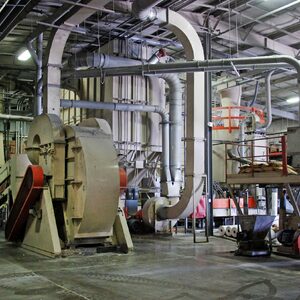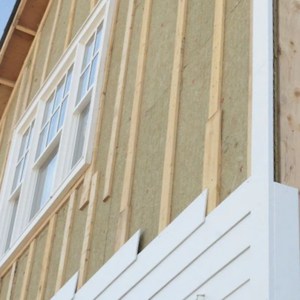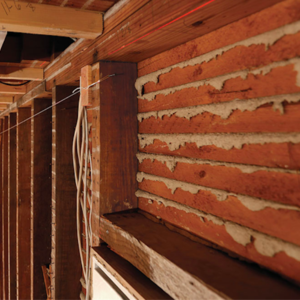
When it comes to fluffy insulation, I’m a bit of an agnostic. I’ve used most types out there, except for denim. Installed properly, most insulations have their place. However, the question of embodied energy and the hidden carbon burden that so often accompany insulation nags me. The more I think about it, the more I think we should be using more cellulose insulation and less of everything else. Cellulose has the effect of sequestering carbon, meaning that it can actually reduce the amount of CO2 in the atmosphere. That said, it’s not a practical choice everywhere, particularly on the smaller jobs.
That line of thinking led me to YouTube yesterday morning because I got to wondering about how the manufacturing process worked for different kinds of fluffy insulation. That led me down several rabbit holes. I wanted to know how manufacturing affects their carbon burdens; and climate change and the potential end of life on the planet notwithstanding, the manufacturing processes are fascinating on their own.
Recycled content
The manufacture of both fiberglass and mineral wool are energy intensive. Both materials begin, essentially, as rock. Fiberglass starts as sand and soda ash. Blended and melted together, it becomes glass. The glass used in fiberglass has a high content of recycled material, around 50%. Most of that is industrial scrap, however. For example, about 20% of the recycled material Johns Manville uses is post-consumer. Still, industrial scrap or post-consumer waste, recycled content is hard to complain about.
Mineral wool is similar in that it, too is, wait for it, mineral-based. Mineral wool has an even higher recycled content than fiberglass, about 75% being post-industrial material such as blast furnace slag.
So, while that’s all well and good, cellulose beats both rock-based insulations in terms of recycled content. It’s about 85% recycled…
Weekly Newsletter
Get building science and energy efficiency advice, plus special offers, in your inbox.

This article is only available to GBA Prime Members
Sign up for a free trial and get instant access to this article as well as GBA’s complete library of premium articles and construction details.
Start Free TrialAlready a member? Log in















19 Comments
This is my first time hearing of denim insulation. I found an image of installed batts and it looks sort of like Cookie Monster stuffed himself into a wall - if nothing else, the stuff is colorful!
Haha, I like that image. Wild stuff, isn't it? I was looking for an article to share with you that I read years ago, when I first heard of denim insulation but I can't find it. I'd love to find a builder who has used it...
Yeah, I'm going to ask my architect/builder if they've ever used it... I think they usually use cellulose. We're already exploring a permanent wood foundation thanks to mutual interest (and the B&S show), so why not throw some fluffy blue insulation into the mix?
https://www.finehomebuilding.com/2009/06/29/why-i-dont-use-cellulose-or-blue-jean-insulation
Interesting take... I'm guessing at least some of these concerns have subsided or been mitigated if cellulose is so widely used/touted here and elsewhere?
It thought it was worth posting, although I'm not sure I agree we should assume either plumbing or roofs need a different insulation material to protect from potential leaks.
Since then I think the moisture buffering qualities of cellulose (and I suppose denim) have come to be seen as mainly positive attributes, enabling the wall to distribute and store moisture without it causing problems, and then to dry.
One point I did find interesting is the idea that a product containing recycled material wasn't necessarily as green as it might seem if the raw material was coming from a commodity stream that would have found another use anyway.
Totally, I appreciate the insight. Agreed on the green point, too - I don't really know how the math works out for cellulose/denim (I assume it ends up being somewhat situational), but it's a great point that the recycled aspect really only ends up being an environmental positive if the material wasn't destined to be recycled in another way.
The critique of denim made sense. As does the recycled product one. But roof or plumbing leaks making a case against cellulose? No. By that logic, we should forgo the drywall and use plexiglass to finish our walls so we can better see what great science experiments we've built. Or never build cavity walls. (ha.)
Worth the read, but that article overreached a bit.
I am in the midst of making an exterior wall dense pack cellulose versus dense pack mineral wool decision. Why do I prefer cellulose buffering any moisture versus hydrophobic mineral wool?
Wood Goobaa,
https://www.greenbuildingadvisor.com/article/hygric-buffering-and-hygric-redistribution
Yes thanks Malcolm I've read that article. I'm in Zone 5, will have air conditioning, and a high quality WRB perm 33 over board sheathing with air gap under the siding.
This particular statement ... "If the leak is minor, the hygroscopic materials can handle the entering water until it can safely evaporate — at least in theory." Not confidence inspiring. It is the big leaks that concern me. Any sponge will absorb only so much moisture.
Wooba Goobaa,
The main argument put forward by builders like Dan Kolbert is that the buffering may be a big factor in keeping exterior sheathing on thick walls safe. My own preference would be to supply enough drying via a rain-screen that the buffering wasn't necessary.
Having done a fair number of renovations over the years, I'd much rather open up a wall with batts of any sort, than loose or dense-packed insulation.
Good roundup on insulation. They will all perform well in walls if installed in an airtight fashion. Without attention paid to infiltration control they are all excellent air filters.
How do hemp batts compare?
Wonderful article! So funny and still full of valuable and hard to get information! Thsnk you!
I used sheepwool insulation at my latest renovation project. (https://havelockwool.com/)really loved working with it! And, if what the producer claims is only half true, it seems like a great choice!
No idea how these „green-indicators“ are calculated, but sheep grown insulation seems pretty good - except their methane contribution vis farts, and the impact of what they’re being fed… i guess everything has good and bad sides…
Pretty expensive though, right?
2$/sqft for R20, 1.5 $/sqft for R13. Seems quite reasonable to me
Silly article somehow cotton farming is now politically incorrect
God help us
Not the farming itself, i guess, but the how it’s done. As with almost everything: done with sustainablility as a point of consideration, too, not just money for this season, cotton farming, like any other farming surely is not a problem…
Log in or become a member to post a comment.
Sign up Log in